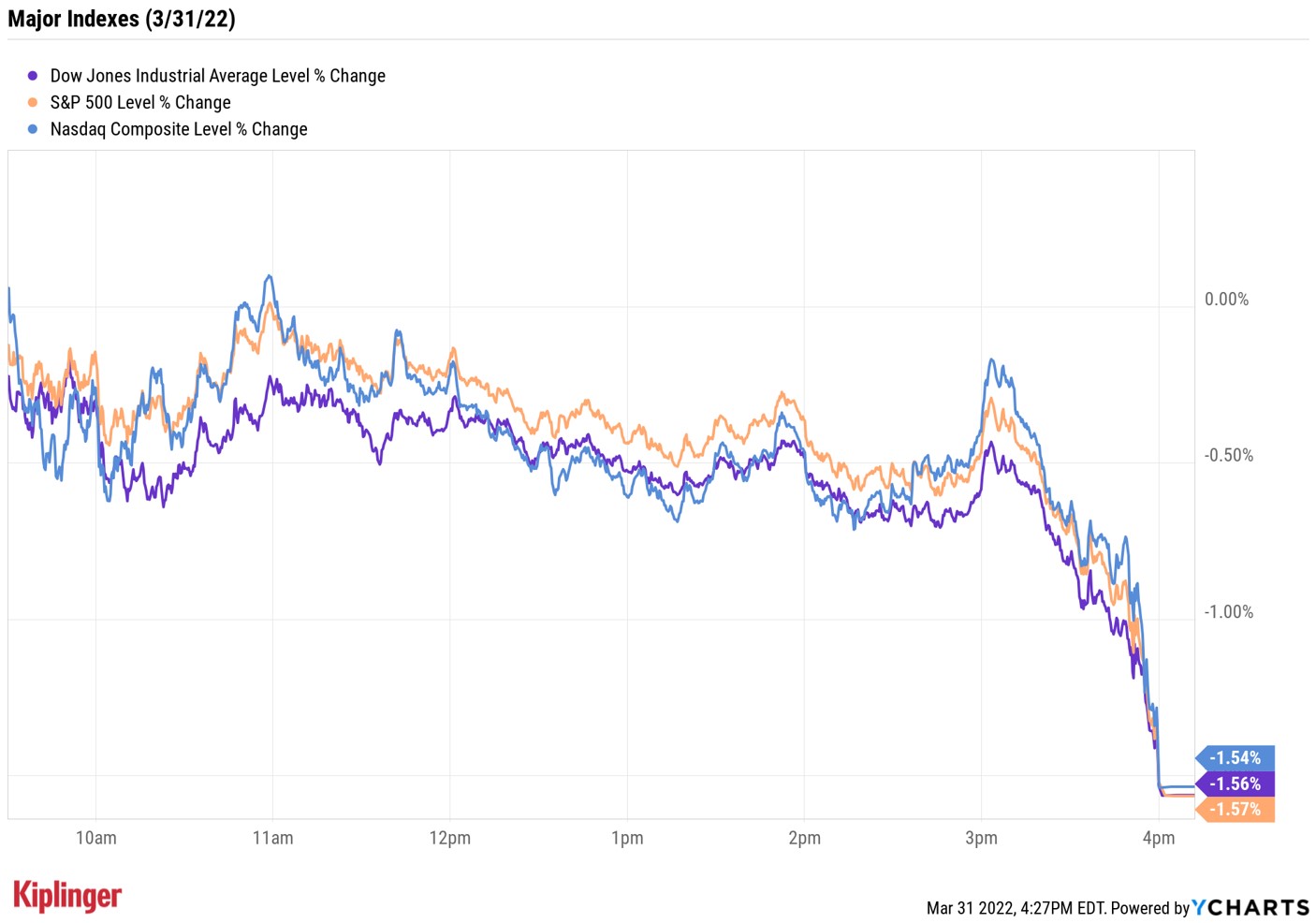Stock Market Today: Stocks Close Out Worst Quarter Since Q1 2020
However, the three major benchmarks turned in solid performances for the month of March.


Stocks spent the last day of March much as they've spent the past few months – trading in negative territory.
Today's decline followed an onslaught of economic reports. On the inflation front, data from the Commerce Department showed that the personal consumption expenditures (PCE) index – which measures the price change of goods and services purchased by consumers – rose 0.6% month-over-month and 6.4% year-over-year in February, the quickest annual increase since 1982.
Meanwhile, consumer spending ticked up 0.2% from January, though this missed economists' consensus estimate.

Sign up for Kiplinger’s Free E-Newsletters
Profit and prosper with the best of expert advice on investing, taxes, retirement, personal finance and more - straight to your e-mail.
Profit and prosper with the best of expert advice - straight to your e-mail.
And ahead of tomorrow's monthly jobs data, a Labor Department report showed weekly jobless claims rose 14,000 last week to 202,000, slightly more than was expected.
Investors also eyed President Joe Biden's plan to tap into strategic oil reserves – releasing a record 180 million barrels – to combat red-hot gas prices. This sent U.S. crude futures down 7% to $100.28 per barrel – their lowest settlement since March 16.
Still, the " release of oil from the Strategic Petroleum Reserve will face two key logistical challenges," says Peter McNally, vice president of Global Sector Lead at Third Bridge. "The first is getting the oil out of the underground storage. This will take months to complete a release of 180 million barrels. The second challenge is converting the crude oil into fuel for consumers."
Selling picked up into the close, with the Dow Jones Industrial Average ending down 1.6% at 34,678, the Nasdaq Composite off 1.5% at 14,220 and the S&P 500 Index giving back 1.6% to 4,530.
For the month, the three indexes gained 2.3%, 3.4% and 3.6%, respectively. As for the first quarter of 2022, the Dow (-4.6%), Nasdaq (-9.1%) and S&P 500 (-5.0%) all finished solidly in the red, marking their worst quarter since Q1 2020.

Other news in the stock market today:
- The small-cap Russell 2000 shed 1% to 2,070. For the month, the index rose 2.1%, paring its first-quarter loss to 6.9%.
- Gold futures rose 0.8% to settle at $1,954 an ounce, bringing their quarterly gain to 6.9%.
- Bitcoin wasn't immune to today's selling, sinking 3.2% to $45,616.75. (Bitcoin trades 24 hours a day; prices reported here are as of 4 p.m.)
- Walgreens Boots Alliance (WBA) was the worst Dow Jones stock today, shedding 5.7% after earnings. In its fiscal second quarter, the drugstore chain reported adjusted earnings of $1.59 per share on $33.8 billion in revenue, beating analysts' consensus estimates. And while the company reiterated its full-year forecast, it warned of slowing demand for COVID-19 testing and vaccines and said investments it made to become more healthcare-oriented, like opening hundreds of doctor's offices, will take time to pay off.
- Advanced Micro Devices (AMD) tumbled 8.3% after Barclays analyst Blayne Curtis downgraded the semiconductor stock to Equalweight from Overweight (the equivalents of Hold and Buy, respectively). Curtis cited increasing competition from Intel (INTC). The analyst also questioned AMD's "growth trajectory coming out of this potential correction," and said he is staying on the sidelines until there is "better clarity as to the magnitude of these corrections and what the competitive landscape will look like as Intel catches up and ARM takes more share."
Energy Stocks, Oil Prices Rack Up Big Q1 Gains
Sure, it was an ugly quarter for most stocks, but not all. The energy sector surged 37.7% in the first three months of 2022 thanks in part to a 33% gain in U.S. crude oil futures. According to Dan Wantrobski, technical strategist and associate director of research at Janney Montgomery Scott, this run in oil prices could have legs.
True, crude futures have pulled back recently from the $125-per-barrel mark touched earlier this month, but Wantrobski calls out a major theme driving inflation these days: "Too much liquidity relative to available assets and investment vehicles" – or, more simply put, "too much money chasing too little of anything."
And given that there's plenty of excess liquidity still lingering in the market, Wantrobski believes the longer-term outlook on oil prices remains bullish.
Investors looking to squeeze more profits from the oil patch aren't hurting for options – our top energy stocks for 2022 include a wide array of operators, or you can dig into specific niches such as these three refiners or these high-yielding midstream energy plays.
But those who prefer to spread their risk across 20 or 30 stocks rather than two or three might consider these seven exchange-traded funds (ETFs) amid rising oil prices. The funds featured here allow you to invest in the overall energy sector, in specific industries and even in oil futures.
Get Kiplinger Today newsletter — free
Profit and prosper with the best of Kiplinger's advice on investing, taxes, retirement, personal finance and much more. Delivered daily. Enter your email in the box and click Sign Me Up.

With over a decade of experience writing about the stock market, Karee Venema is the senior investing editor at Kiplinger.com. She joined the publication in April 2021 after 10 years of working as an investing writer and columnist at a local investment research firm. In her previous role, Karee focused primarily on options trading, as well as technical, fundamental and sentiment analysis.
-
 The AI Doctor Coming to Read Your Test Results
The AI Doctor Coming to Read Your Test ResultsThe Kiplinger Letter There’s big opportunity for AI tools that analyze CAT scans, MRIs and other medical images. But there are also big challenges that human clinicians and tech companies will have to overcome.
By John Miley Published
-
 The Best Places for LGBTQ People to Retire Abroad
The Best Places for LGBTQ People to Retire AbroadLGBTQ people can safely retire abroad, but they must know a country’s laws and level of support — going beyond the usual retirement considerations.
By Drew Limsky Published
-
 Stock Market Today: Stocks Surge to Close a Volatile Week
Stock Market Today: Stocks Surge to Close a Volatile WeekIt was another day with a week's worth of both news and price action, but it ended on a strongly positive note.
By David Dittman Published
-
 Stock Market Today: Uncertainty Proliferates: Dow Loses 1,014 Points
Stock Market Today: Uncertainty Proliferates: Dow Loses 1,014 PointsWeaker-than-expected consumer inflation data wasn't enough to stabilize sentiment during another volatile day for financial markets.
By David Dittman Published
-
 Stock Market Today: Tariff Pause Triggers 3,000-Point Dow Rally
Stock Market Today: Tariff Pause Triggers 3,000-Point Dow RallyThe bond market is sending concerning signals as the Trump administration executes its rapid reordering of global trade relationships.
By David Dittman Published
-
 Stock Market Today: Tariff Talks Drive Another Up-and-Down Day
Stock Market Today: Tariff Talks Drive Another Up-and-Down DayTrade war negotiations are happening, but the "fear gauge" is gyrating, and investors, traders and speculators are still searching for signs of a bottom.
By David Dittman Published
-
 Stock Market Today: Trump Pushes Dow Into 2,600-Point Swing
Stock Market Today: Trump Pushes Dow Into 2,600-Point SwingTariffs and trade war weigh on prices across global financial markets, with little light at the end of the tunnel.
By David Dittman Published
-
 Stock Market Today: Dow Drops Another 2,231 Points to Hit a Correction
Stock Market Today: Dow Drops Another 2,231 Points to Hit a CorrectionThe Nasdaq Composite, meanwhile, entered a new bear market with its latest slide.
By Karee Venema Published
-
 Stock Market Today: Dow Dives 1,679 Points on Trump Tariff Shock
Stock Market Today: Dow Dives 1,679 Points on Trump Tariff ShockU.S. stocks lost roughly $3.1 trillion in market cap on Thursday – the biggest one-day decline since the start of the COVID-19 pandemic in March 2020.
By Karee Venema Published
-
 Stock Market Today: It's the Old Up-Down Again on Liberation Day
Stock Market Today: It's the Old Up-Down Again on Liberation DayMarkets look forward to what comes with the reordering of 80-year-old global trade relationships.
By David Dittman Published